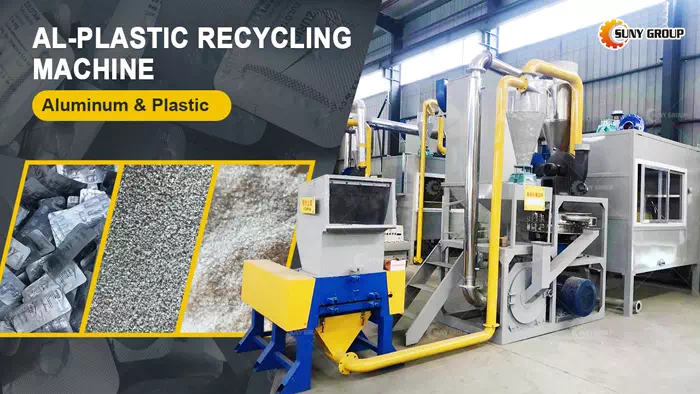As an industrial product, metal aluminum has a wide range of applications. At present, aluminum-plastic films are widely used as packaging materials. However, a large amount of non-degradable waste produced by it pollutes the environment and causes serious waste of resources.
Aluminum-plastic separation equipment has the characteristics of low noise, large output, and advanced technology. The main purpose is to realize the separation of aluminum-plastic materials by crushing and separating various aluminum-plastic materials. The aluminum-plastic separator recycles aluminum-plastic waste such as aluminum-plastic panels, which can not only maintain the original quality of aluminum, but also recycle plastics, resulting in huge economic benefits.

The aluminum-plastic separation equipment is composed of a crusher, a feeding conveyor, a pulverizer, a high-voltage electrostatic separator, and dust removal equipment.
Process flow of plastic-aluminum separator:
1. Grinder: crush aluminum-plastic materials, and the finished material after crushing is about 10mm;
2. Automatic feeding machine: Put the crushed aluminum-plastic material into the automatic feeding machine to make it evenly loaded;
3. Pulverizer: Grind the aluminum-plastic mixture into very fine powder.
4. Rotary vibrating screen: Screen the ground aluminum-plastic materials, the materials that meet the particle size requirements enter the high-voltage electrostatic machine through the bucket elevator for final treatment, and the materials that do not meet the requirements return to the mill for processing and grinding again;
5. Hopper: Dust collection and discharge;
6. High-voltage electrostatic separator: use electrostatic separation to separate metal and plastic, so that aluminum and plastic can be completely separated.
Recently, the new recycling method of aluminum-plastic composite film adopts physical separation method. The physical separation method refers to the method of separating and processing through the aluminum-plastic separator. The aluminum-plastic separator extracts aluminum and plastic from the aluminum-plastic composite film through dry crushing and physical separation, and the separation purity can reach more than 99%. Through the SUNY GROUP aluminum-plastic separator, the separated aluminum and plastic can be directly used for secondary use, alleviating the shortage of aluminum and plastic raw materials in the market. Aluminum separator is currently the most popular aluminum-plastic composite film processing equipment!






